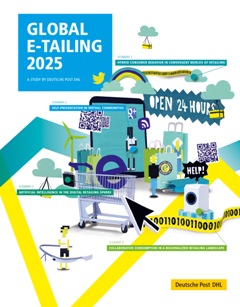
The “Global E-Tailing 2025” report prophesies that a decade from now, online retail will gain even more importance than expected so far, not just in developed countries, but also in emerging markets.
E-commerce could rise from the current 8 percent of overall trading volume in Europe to up to 40 percent in developed countries and up to 30 percent in today’s emerging markets.
And logistics will play a key role by providing companies important competitive advantages, such as deliveries within a few hours on the day of ordering, flexible receiving and return times, as well as resilient logistics and value-added concepts in emerging countries.
“In the future, logistics will take over the role as an enabler for online retailers even more than today,” said Jurgen Gerdes, CEO of Post-eCommerce-Parcel at Deutsche Post DHL.
The study also presented four global scenarios of what the electronic world of shopping could look like for consumers and businesses in the near future.
In the first scenario, today’s emerging markets will be the engine of growth 11 years from now. A strong global economy and a stable middle class will have established a true “Everywhere Commerce.” Consumers will receive their purchases much faster than today, with express shipments being delivered in less than 24 hours and measured in minutes.
In the second scenario, the world economy has grown rapidly, creating an affluent and consumption-oriented middle class. Here, niche sites will mark the biggest gains as self-realization and individual lifestyles gain increasing appeal. The dealers are often part of the community, their selling points being quality and authenticity.
In the third scenario, a highly developed digital culture has evolved, in which almost all products will be sold online and consumers will receive support by avatars. To protect manufacturers from counterfeit, logistics companies will offer protected supply chains.
However, the study also highlights possible crisis scenarios. In the fourth scenario, the worldwide consumption patterns are affected by a global economy that suffers another financial crisis and a surge in energy and raw material prices. “Under these circumstances, people could adopt a Do-It-Yourself mentality instead and sharing models instead of the ‘all new’ approach,” said the study.
The different future projections are based on a detailed analysis of the most influential factors in global commerce—from energy and raw material prices to technological, political and social factors to retail and consumption patterns.
The research examined selected developed and emerging markets around the world and studied purchasing and logistics trends in 12 international metropolises, including New York, Moscow, Bangalore, Jakarta, and Lagos.
The scenarios contained in the paper as well as the essays from logistics experts that accompany these predictions all point to intensifying competition in electronic retail, whether on global, national, or regional level.
Said Gerdes: “We don’t know for certain what the world will look like in 2025, but the study’s various scenarios show how rapidly the global retail sector—online and offline—is changing and that logistics will be a focal point of these change processes.”
The “Global E-Tailing 2025” study was initiated by Deutsche Post DHL with participation of the trend research institutions Z_punkt and See More as well as international experts from retail, logistics, and academia. The logistics company said it is the first global scenario study on cross-border online commerce and its implications for the logistics industry.









